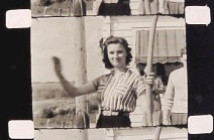Disneyland Dream
Robbins Barstow, 35 min., 16mm, 1956
Preserved by the Library of Congress
Added to National Film Registry: 2008
Essay by Liz Coffey
Lifelong amateur moviemaker Robbins Barstow (1919-2010) brought passion and playfulness to all aspects of his life. He started making movies when he was a teenager, creating in his own New England neighborhood Tarzan and the Rocky Gorge (1936), starring himself and his family. His family would go on to star in many of his films. He made nearly 100 films during his long life.
With wife Meg (to whom he was married for 68 years) and their three children, Robbins not only documented “everyday life” and family travel adventures in home movies, but also tackled theatrical themes, such as The Abbakadabba Coopno (1941), a short film made at a New Jersey interracial summer camp for inner city children, Christian pacifists, & consciencious objectors. Robbins himself was a conscientious objector during WWII, and later an environmental conservationist, an educator, and an advocate for whales.
In 1956, when Scotch brand cellophane tape announced a slogan contest for which the prize was a trip to the newly opened Disneyland, Robbins enlisted the help of his family to enter the contest, and documented the story with his 16mm camera. The resulting epic, Disneyland Dream (1956), is a well-paced, playful documentary/home movie/amateur film, complete with visual jokes. Although long for an amateur film at nearly 35 minutes, it is compelling, and moves along jauntily.
Disneyland Dream is an adventure in three acts, each of nearly equal length. Act One: Connecticut, 1956. Scotch Tape announces a contest, and the entire Barstow clan takes part. Robbins documents the affair, from the promotional advertising of the contest to the delivery of a telegram. Act Two: Barstows Go West! The family heads to California in their matching but variously colored Davy Crocket jackets, which will help us to recognize them in a crowd, a detail which proves extremely important later! They spend some time figuring out the Southern California scene, and enjoying their fancy digs in Pasadena. Final Act: Disneyland Dream Realized. The family spends four days exploring the new theme park, and the 16mm camera loaded with Kodachrome is like a sixth member of the family, the one who remembers every moment.
Details pepper the film. Robbins included many things which probably didn’t seem particularly important at the time, but which are fascinating to a 21st century audience. The practically cliché 1950s neighborhood / neighbors of the Barstows are super charming. The Barstows fly out of Bradley Field near Hartford, CT, which is now a very different Bradley International Airport. Robbins’ narration acknowledges the differences, which really do seem pretty quaint, some 60 years on.
The narration by Robbins was there from the beginning. In a 2009 interview with UnionDocs, Robbins recalled showing the film to friends and neighbors soon after it was completed, talking his audience through the story. Eventually, after multiple screenings, the narration took firm shape, and the polished version Robins later recorded was well known and well rehearsed.
[Pro Tip: when you watch a stranger’s home movie you find at a junk shop or online or wherever, watch it and imagine a narration like the one recorded by Robbins. Many, if not most, home movies would have been accompanied by live informative and comical narration by the filmmaker or his or her partner.]
A preservationist at heart, Robbins had his films transferred to VHS in the 1990s, allowing him to record for posterity what was usually his live narration. He was able to distribute his films on videotape, later on DVD, and showed them on local cable-access television.
In 2003, Robbins, then 84, made the two-hour journey from Whethersfield, CT to the first annual Home Movie Day (HMD) in Boston, MA, having heard about the event at his local public library. His films Tarzan and the Rocky Gorge (1936) and its sequel, The Return of Tarzan, and the Lost, Last Whale (1974) were big hits. We recognized him immediately as an amateur film auteur.
Robbins attended many subsequent HMD events, sparking a re-discovery of his work. His enthusiasm hadn’t waned since he started making films as a teenager in the 1930s, and finding a new amateur-film-loving audience, film archivists, and the Center for Home Movies (CHM), only fanned the flames.
Inspired by HMD and CHM, Robbins and Meg traveled all over the USA with the films and Robbins became an advocate for the appreciation of home movies and amateur films. He was able to distribute his own films internationally on “the world-wide internet.” He also made them available at local libraries and donated the originals to the Library of Congress in 2007. Of course he brought his movie camera along to record meeting the Librarian of Congress and the signing the agreement gifting his films to our country.
How many of us wish we had our family’s adventures documented with such loving care? The Barstow’s recorded memory is added to the national patrimony with the donation of the film to the Library of Congress, a stand-in for many Americans’ mid-century experience.
Born in 1919, only seven years after the introduction of the first amateur film stock, Robbins died in 2010. His eye, voice, and sense of humor live on in Disneyland Dream, the fifth home movie added to the National Film Registry.
Liz Coffey, a film appraiser and former film archivist, lives in the country with her husband, cats, and chickens. She hosted HMD events for a decade, and occasionally shoots her own home movies on Super 8. She is a cyclist, a vegetarian, an atheist, and collects typewriters and toasters

